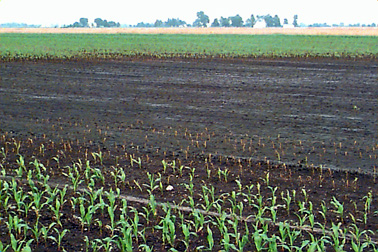Post-Flood Syndrome:
Interesting Research
R.L. (Bob) Nielsen ,
Agronomy Department ,
Purdue University, West Lafayette, IN
47907-1150
Internet address: rnielsen@purdue.edu
 Frequent
and excessive rainfall throughout Indiana during the past several months
has resulted in extensive flooding of river bottoms and ponding in
low-lying areas of other fields. Some river bottom ground has yet to be
planted for the first time this year, some has been replanted two or more
times but is still devoid of crop growth because of continued flooding.
Many fields throughout the state contain "wet holes" that have
ponded numerous times this growing season, killing young corn or soybean,
and have not been replanted.
Frequent
and excessive rainfall throughout Indiana during the past several months
has resulted in extensive flooding of river bottoms and ponding in
low-lying areas of other fields. Some river bottom ground has yet to be
planted for the first time this year, some has been replanted two or more
times but is still devoid of crop growth because of continued flooding.
Many fields throughout the state contain "wet holes" that have
ponded numerous times this growing season, killing young corn or soybean,
and have not been replanted.
Where such fields or parts of fields have been left fallow due to
flooding or ponding, corn growth the following year sometimes displays
symptoms of phosphorus deficiency even if adequate levels of soil
phosphorus exist. Recently published research from USDA-ARS at the Univ.
of Nebraska sheds some light on this phenomenon known as Post Flood
Syndrome. The complete citation is : J.R. Ellis, Post Flood Syndrome
and Vesicular-Arbuscular Mycorrhizal Fungi, J. Prod. Agric. 11:200-204
(1998).
The fungi referred to in the article's title (acronym: VAM) are plant
fungi that routinely colonize roots of crops in a mutually beneficial
(symbiotic) relationship. The fungi benefit from the host plants'
resources, the crop benefits from the increased nutrient absorption zone
offered by the fungal hyphae (the many threads that make up the mycelium
of fungi).
The bottom line of the research is that prolonged fallow periods, such
as caused by flooding or ponding, significantly reduce the populations of
the VAM fungi in the soil. Following the seeding of a subsequent crop, the
VAM fungi slowly recolonize and restore their populations. Until the
populations of the VAM fungi are sufficient, plant nutrient uptake
(especially phosphorus) is restricted and nutrient deficiency symptoms can
occur.
The author suggests several alternatives to forestall the development of
the Post Flood Syndrome in corn. One is to apply 60-80 lbs per acre of
starter phosphorus to the following corn crop, equal to 16 to 21 gallons
of 10-34-0 starter fertilizer (easily accomplished by many Indiana corn
growers). Another alternative is to seed a host cover crop in the fall to
encourage the regeneration of the VAM fungal populations (seeding the
areas to corn or soybean now would accomplish the same thing). While VAM
fungal inoculants exist, the author suggests that using them would be too
expensive for field crops.
For more information, contact the author at
jellis@unlinfo.unl.edu.

For other information about corn, take a look at
the Corn Growers Guidebook on the World Wide Web at
http://www.agry.purdue.edu/ext/corn/
End of Document
 Frequent
and excessive rainfall throughout Indiana during the past several months
has resulted in extensive flooding of river bottoms and ponding in
low-lying areas of other fields. Some river bottom ground has yet to be
planted for the first time this year, some has been replanted two or more
times but is still devoid of crop growth because of continued flooding.
Many fields throughout the state contain "wet holes" that have
ponded numerous times this growing season, killing young corn or soybean,
and have not been replanted.
Frequent
and excessive rainfall throughout Indiana during the past several months
has resulted in extensive flooding of river bottoms and ponding in
low-lying areas of other fields. Some river bottom ground has yet to be
planted for the first time this year, some has been replanted two or more
times but is still devoid of crop growth because of continued flooding.
Many fields throughout the state contain "wet holes" that have
ponded numerous times this growing season, killing young corn or soybean,
and have not been replanted.